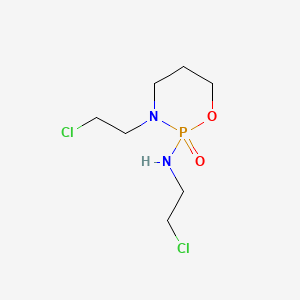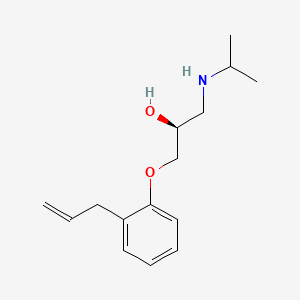
Ifosfamid
Übersicht
Beschreibung
Ifosfamid ist ein Chemotherapeutikum, das zur Behandlung verschiedener Krebsarten eingesetzt wird, darunter Hodenkrebs, Weichteilsarkom, Osteosarkom, Blasenkrebs, kleinzelliger Lungenkrebs, Gebärmutterhalskrebs und Eierstockkrebs . Es gehört zur Familie der alkylierenden Agenzien und Stickstoff-Senf-Medikamente . This compound wirkt, indem es die DNA-Verdopplung und die RNA-Bildung stört und so das Wachstum von Krebszellen hemmt .
Herstellungsmethoden
This compound kann auf verschiedenen Wegen synthetisiert werden. Eine Methode beinhaltet die Reaktion einer this compound-Zwischenstufe mit einem Chlorierungsmittel, gefolgt von einer Cyclisierung unter Einwirkung einer organischen Base . Eine andere Methode verwendet Aziridin als Ausgangsmaterial, das einer Cyclisierung und anschließenden Reaktionen unterzogen wird, um this compound zu bilden . Industrielle Produktionsmethoden beinhalten häufig die Optimierung dieser Synthesewege, um eine hohe Ausbeute und Reinheit zu gewährleisten und gleichzeitig den Einsatz von toxischen und explosiven Chemikalien zu minimieren .
Wirkmechanismus
Target of Action
Ifosfamide is an alkylating and immunosuppressive agent used in chemotherapy for the treatment of various cancers . Its primary targets are the DNA molecules within cancer cells . By interacting with DNA, Ifosfamide interferes with the cell’s ability to replicate, leading to cell death and slowing the growth and spread of cancer .
Mode of Action
Ifosfamide works by damaging the DNA in cancer cells, which leads to cell death . The cytotoxic action of Ifosfamide primarily occurs through the alkylation of DNA, specifically by attaching the N-7 position of guanine to its reactive electrophilic groups . This interaction disrupts the duplication of DNA and the creation of RNA , thereby inhibiting the proliferation of cancer cells .
Biochemical Pathways
These crosslinks facilitate cellular damage and death . The metabolism of Ifosfamide can be affected by a number of factors, including autoinduction, drug combinations, and/or polymorphisms of genes encoding enzymes that metabolize and transport Ifosfamide .
Pharmacokinetics
Ifosfamide requires biotransformation in the liver by mixed-function oxidases (cytochrome P450 system) before it becomes active . The activation and deactivation of Ifosfamide in vivo and in rat liver microsomes are mediated by different CYP isoenzymes: 3A (CYP3A) plus CYP2B1/CYP2C11 and CYP3A, respectively . The specific isoenzymes responsible for metabolism in humans may differ significantly from those in rats .
Result of Action
The molecular and cellular effects of Ifosfamide’s action include the disruption of DNA replication and RNA creation , leading to cell death and slowing the growth and spread of cancer . Ifosfamide can exert a bimodal antitumor action with cytotoxic and immunomodulatory effects combined with adoptive immunotherapy .
Action Environment
Environmental factors can influence the action, efficacy, and stability of Ifosfamide. For example, the metabolism of Ifosfamide can be affected by a number of factors, including autoinduction, drug combinations, and/or polymorphisms of genes encoding enzymes that metabolize and transport Ifosfamide . Understanding these factors can help optimize the use of Ifosfamide in cancer treatment.
Wissenschaftliche Forschungsanwendungen
Ifosfamide is widely used in scientific research, particularly in the fields of chemistry, biology, medicine, and industry. In medicine, it is used as a chemotherapeutic agent to treat various cancers . In biology, it is used to study the mechanisms of DNA damage and repair, as well as the effects of alkylating agents on cellular processes . In chemistry, it serves as a model compound for studying the reactivity of nitrogen mustards and the development of new anticancer agents . Industrial applications include the development of nanostructured lipid carriers for oral delivery of ifosfamide, which aim to improve its stability and bioavailability .
Biochemische Analyse
Biochemical Properties
Ifosfamide is metabolized by the liver CYP450 enzymes to its active metabolites . These metabolites, phosphoramide mustard derivatives and acrolein, bind to the DNA inhibiting DNA synthesis . The metabolism of Ifosfamide in vivo and in rat liver microsomes is mediated by different CYP isoenzymes: 3A (CYP3A) plus CYP2B1/ CYP2C11 and CYP3A, respectively .
Cellular Effects
Ifosfamide and its metabolites can cause toxicity of normal cells due to induction of oxidative stress . This can lead to hematological toxicity and liver injury .
Molecular Mechanism
The molecular mechanism of Ifosfamide involves its metabolites binding to the DNA, which inhibits DNA synthesis . This action is facilitated by the liver CYP450 enzymes .
Temporal Effects in Laboratory Settings
In most clinical pharmacokinetic studies, the phenomenon of autoinduction has been observed, but the mechanism is not completely understood .
Dosage Effects in Animal Models
The effects of Ifosfamide vary with different dosages in animal models . High doses of Ifosfamide can cause hematological toxicity, oxidative stress, inflammation, and hepatotoxicity .
Metabolic Pathways
Ifosfamide is involved in various metabolic pathways, interacting with enzymes such as CYP3A, CYP2B1, and CYP2C11 . The specific isoenzymes responsible for Ifosfamide metabolism may lead to an improved efficacy/toxicity ratio by modulation of the metabolic pathways .
Transport and Distribution
Whether Ifosfamide is specifically transported by erythrocytes and which activated Ifosfamide metabolites play a key role in this transport is currently being debated .
Subcellular Localization
The subcellular localization of Ifosfamide and its metabolites is a complex process that involves various enzymes and transporters .
Vorbereitungsmethoden
Ifosfamide can be synthesized through several routes. One method involves reacting an ifosfamide intermediate with a chlorinating agent, followed by cyclization under the action of an organic base . Another method uses aziridine as the starting material, which undergoes cyclization and subsequent reactions to form ifosfamide . Industrial production methods often involve optimizing these synthetic routes to ensure high yield and purity while minimizing the use of toxic and explosive chemicals .
Analyse Chemischer Reaktionen
Ifosfamid durchläuft verschiedene chemische Reaktionen, einschließlich Oxidation, Reduktion und Substitution. Es wird in der Leber durch Cytochrom-P450-Enzyme metabolisiert, was zur Bildung von aktiven und inaktiven Metaboliten führt . Häufige Reagenzien, die in diesen Reaktionen verwendet werden, sind gemischtfunktionelle Oxidationsmittel und organische Basen . Hauptprodukte, die aus diesen Reaktionen entstehen, sind Chlorethylacetaldehyd und andere Metaboliten, die zu den therapeutischen und toxischen Wirkungen des Medikaments beitragen .
Wissenschaftliche Forschungsanwendungen
This compound wird in der wissenschaftlichen Forschung weit verbreitet, insbesondere in den Bereichen Chemie, Biologie, Medizin und Industrie. In der Medizin wird es als Chemotherapeutikum zur Behandlung verschiedener Krebsarten eingesetzt . In der Biologie wird es verwendet, um die Mechanismen der DNA-Schädigung und -Reparatur sowie die Auswirkungen von alkylierenden Agenzien auf zelluläre Prozesse zu untersuchen . In der Chemie dient es als Modellverbindung zur Untersuchung der Reaktivität von Stickstoff-Senfstoffen und zur Entwicklung neuer Antikrebsmittel . Industrielle Anwendungen umfassen die Entwicklung von nanostrukturierten Lipidträgern zur oralen Verabreichung von this compound, die darauf abzielen, seine Stabilität und Bioverfügbarkeit zu verbessern .
Wirkmechanismus
This compound benötigt eine Biotransformation in der Leber durch das Cytochrom-P450-System, bevor es aktiv wird . Die aktiven Metaboliten von this compound bilden DNA-Vernetzungen an der Guanin-N-7-Position, was zu Zellschäden und -tod führt . Diese Störung der DNA-Replikation und RNA-Produktion hemmt das Wachstum und die Proliferation von Krebszellen . Die genauen molekularen Ziele und Pfade, die an der Zytotoxizität von this compound beteiligt sind, werden noch untersucht, aber es ist bekannt, dass es die DNA- und RNA-Synthese beeinträchtigt .
Vergleich Mit ähnlichen Verbindungen
Ifosfamid ist chemisch verwandt mit anderen Stickstoff-Senfstoffen, wie z. B. Cyclophosphamid, Trofosfamid, Mafosfamid, Sufofammid und Glufosfamid . Im Vergleich zu diesen Verbindungen weist this compound einzigartige pharmakokinetische Eigenschaften auf, darunter eine längere Halbwertszeit und unterschiedliche Stoffwechselwege . Seine Fähigkeit, DNA-Vernetzungen zu bilden, und seine Wirksamkeit bei der Behandlung einer Vielzahl von Krebsarten machen es zu einem wertvollen Chemotherapeutikum .
Eigenschaften
IUPAC Name |
N,3-bis(2-chloroethyl)-2-oxo-1,3,2λ5-oxazaphosphinan-2-amine | |
|---|---|---|
| Source | PubChem | |
| URL | https://pubchem.ncbi.nlm.nih.gov | |
| Description | Data deposited in or computed by PubChem | |
InChI |
InChI=1S/C7H15Cl2N2O2P/c8-2-4-10-14(12)11(6-3-9)5-1-7-13-14/h1-7H2,(H,10,12) | |
| Source | PubChem | |
| URL | https://pubchem.ncbi.nlm.nih.gov | |
| Description | Data deposited in or computed by PubChem | |
InChI Key |
HOMGKSMUEGBAAB-UHFFFAOYSA-N | |
| Source | PubChem | |
| URL | https://pubchem.ncbi.nlm.nih.gov | |
| Description | Data deposited in or computed by PubChem | |
Canonical SMILES |
C1CN(P(=O)(OC1)NCCCl)CCCl | |
| Source | PubChem | |
| URL | https://pubchem.ncbi.nlm.nih.gov | |
| Description | Data deposited in or computed by PubChem | |
Molecular Formula |
C7H15Cl2N2O2P | |
| Source | PubChem | |
| URL | https://pubchem.ncbi.nlm.nih.gov | |
| Description | Data deposited in or computed by PubChem | |
DSSTOX Substance ID |
DTXSID7020760 | |
| Record name | Ifosfamide | |
| Source | EPA DSSTox | |
| URL | https://comptox.epa.gov/dashboard/DTXSID7020760 | |
| Description | DSSTox provides a high quality public chemistry resource for supporting improved predictive toxicology. | |
Molecular Weight |
261.08 g/mol | |
| Source | PubChem | |
| URL | https://pubchem.ncbi.nlm.nih.gov | |
| Description | Data deposited in or computed by PubChem | |
Physical Description |
Solid | |
| Record name | Ifosfamide | |
| Source | Human Metabolome Database (HMDB) | |
| URL | http://www.hmdb.ca/metabolites/HMDB0015312 | |
| Description | The Human Metabolome Database (HMDB) is a freely available electronic database containing detailed information about small molecule metabolites found in the human body. | |
| Explanation | HMDB is offered to the public as a freely available resource. Use and re-distribution of the data, in whole or in part, for commercial purposes requires explicit permission of the authors and explicit acknowledgment of the source material (HMDB) and the original publication (see the HMDB citing page). We ask that users who download significant portions of the database cite the HMDB paper in any resulting publications. | |
Solubility |
Soluble in water, 1.50e+01 g/L | |
| Record name | Ifosfamide | |
| Source | DrugBank | |
| URL | https://www.drugbank.ca/drugs/DB01181 | |
| Description | The DrugBank database is a unique bioinformatics and cheminformatics resource that combines detailed drug (i.e. chemical, pharmacological and pharmaceutical) data with comprehensive drug target (i.e. sequence, structure, and pathway) information. | |
| Explanation | Creative Common's Attribution-NonCommercial 4.0 International License (http://creativecommons.org/licenses/by-nc/4.0/legalcode) | |
| Record name | IFOSFAMIDE | |
| Source | Hazardous Substances Data Bank (HSDB) | |
| URL | https://pubchem.ncbi.nlm.nih.gov/source/hsdb/7023 | |
| Description | The Hazardous Substances Data Bank (HSDB) is a toxicology database that focuses on the toxicology of potentially hazardous chemicals. It provides information on human exposure, industrial hygiene, emergency handling procedures, environmental fate, regulatory requirements, nanomaterials, and related areas. The information in HSDB has been assessed by a Scientific Review Panel. | |
| Record name | Ifosfamide | |
| Source | Human Metabolome Database (HMDB) | |
| URL | http://www.hmdb.ca/metabolites/HMDB0015312 | |
| Description | The Human Metabolome Database (HMDB) is a freely available electronic database containing detailed information about small molecule metabolites found in the human body. | |
| Explanation | HMDB is offered to the public as a freely available resource. Use and re-distribution of the data, in whole or in part, for commercial purposes requires explicit permission of the authors and explicit acknowledgment of the source material (HMDB) and the original publication (see the HMDB citing page). We ask that users who download significant portions of the database cite the HMDB paper in any resulting publications. | |
Mechanism of Action |
The exact mechanism of ifosfamide has not been determined, but appears to be similar to other alkylating agents. Ifosfamide requires biotransformation in the liver by mixed-function oxidases (cytochrome P450 system) before it becomes active. After metabolic activation, active metabolites of ifosfamide alkylate or bind with many intracellular molecular structures, including nucleic acids. The cytotoxic action is primarily through the alkylation of DNA, done by attaching the N-7 position of guanine to its reactive electrophilic groups. The formation of inter and intra strand cross-links in the DNA results in cell death., Mechanism of action: metabolites cause alkylation of DNA. /from table/, Ifosfamide, a structural analog of cyclophosphamide, belongs to the oxazaphosphorine class of antitumor alkylating agents which must be activated by the mixed function oxidase system of the liver. The 4-hydroxy oxazaphosphorines are a reactive species capable of interacting with nucleic acids & cellular materials to cause cell damage & death. The 4-hydroxy metabolite spontaneously liberates acrolein in many sites throughout the body & it is this substance that is responsible for oxazaphosphorine urotoxicity. Both ifosfamide & cyclophosphamide produce cystitis characterized by tissue edema & ulceration followed by sloughing of mucosal epithelial cells, necrosis of smooth muscle fibers & arteries, & culminating in focal hemorrhage. The selective urotoxicity of oxazaphosphorine occurs because the bladder contains a very low concn of thiol cmpds (glutathione, cysteine) which, by virtue of their nucleophilic sulfhydryl groups, are able to react & neutralize many reactive chemicals. Because the metabolic activation of ifosfamide proceeds more slowly than that of cyclophosphamide, doses of ifosfamide are 3-4 times higher than those of cyclophosphamide. This explains the higher incidence of urotoxicity associated with ifosfamide. | |
| Record name | Ifosfamide | |
| Source | DrugBank | |
| URL | https://www.drugbank.ca/drugs/DB01181 | |
| Description | The DrugBank database is a unique bioinformatics and cheminformatics resource that combines detailed drug (i.e. chemical, pharmacological and pharmaceutical) data with comprehensive drug target (i.e. sequence, structure, and pathway) information. | |
| Explanation | Creative Common's Attribution-NonCommercial 4.0 International License (http://creativecommons.org/licenses/by-nc/4.0/legalcode) | |
| Record name | IFOSFAMIDE | |
| Source | Hazardous Substances Data Bank (HSDB) | |
| URL | https://pubchem.ncbi.nlm.nih.gov/source/hsdb/7023 | |
| Description | The Hazardous Substances Data Bank (HSDB) is a toxicology database that focuses on the toxicology of potentially hazardous chemicals. It provides information on human exposure, industrial hygiene, emergency handling procedures, environmental fate, regulatory requirements, nanomaterials, and related areas. The information in HSDB has been assessed by a Scientific Review Panel. | |
Color/Form |
Crystals from anhyd ether, White crystalline powder | |
CAS No. |
3778-73-2 | |
| Record name | Ifosfamide | |
| Source | CAS Common Chemistry | |
| URL | https://commonchemistry.cas.org/detail?cas_rn=3778-73-2 | |
| Description | CAS Common Chemistry is an open community resource for accessing chemical information. Nearly 500,000 chemical substances from CAS REGISTRY cover areas of community interest, including common and frequently regulated chemicals, and those relevant to high school and undergraduate chemistry classes. This chemical information, curated by our expert scientists, is provided in alignment with our mission as a division of the American Chemical Society. | |
| Explanation | The data from CAS Common Chemistry is provided under a CC-BY-NC 4.0 license, unless otherwise stated. | |
| Record name | Ifosfamide [USAN:USP:INN:BAN:JAN] | |
| Source | ChemIDplus | |
| URL | https://pubchem.ncbi.nlm.nih.gov/substance/?source=chemidplus&sourceid=0003778732 | |
| Description | ChemIDplus is a free, web search system that provides access to the structure and nomenclature authority files used for the identification of chemical substances cited in National Library of Medicine (NLM) databases, including the TOXNET system. | |
| Record name | Ifosfamide | |
| Source | DrugBank | |
| URL | https://www.drugbank.ca/drugs/DB01181 | |
| Description | The DrugBank database is a unique bioinformatics and cheminformatics resource that combines detailed drug (i.e. chemical, pharmacological and pharmaceutical) data with comprehensive drug target (i.e. sequence, structure, and pathway) information. | |
| Explanation | Creative Common's Attribution-NonCommercial 4.0 International License (http://creativecommons.org/licenses/by-nc/4.0/legalcode) | |
| Record name | ifosfamide | |
| Source | DTP/NCI | |
| URL | https://dtp.cancer.gov/dtpstandard/servlet/dwindex?searchtype=NSC&outputformat=html&searchlist=759154 | |
| Description | The NCI Development Therapeutics Program (DTP) provides services and resources to the academic and private-sector research communities worldwide to facilitate the discovery and development of new cancer therapeutic agents. | |
| Explanation | Unless otherwise indicated, all text within NCI products is free of copyright and may be reused without our permission. Credit the National Cancer Institute as the source. | |
| Record name | ifosfamide | |
| Source | DTP/NCI | |
| URL | https://dtp.cancer.gov/dtpstandard/servlet/dwindex?searchtype=NSC&outputformat=html&searchlist=109724 | |
| Description | The NCI Development Therapeutics Program (DTP) provides services and resources to the academic and private-sector research communities worldwide to facilitate the discovery and development of new cancer therapeutic agents. | |
| Explanation | Unless otherwise indicated, all text within NCI products is free of copyright and may be reused without our permission. Credit the National Cancer Institute as the source. | |
| Record name | Ifosfamide | |
| Source | EPA DSSTox | |
| URL | https://comptox.epa.gov/dashboard/DTXSID7020760 | |
| Description | DSSTox provides a high quality public chemistry resource for supporting improved predictive toxicology. | |
| Record name | Ifosfamide | |
| Source | European Chemicals Agency (ECHA) | |
| URL | https://echa.europa.eu/substance-information/-/substanceinfo/100.021.126 | |
| Description | The European Chemicals Agency (ECHA) is an agency of the European Union which is the driving force among regulatory authorities in implementing the EU's groundbreaking chemicals legislation for the benefit of human health and the environment as well as for innovation and competitiveness. | |
| Explanation | Use of the information, documents and data from the ECHA website is subject to the terms and conditions of this Legal Notice, and subject to other binding limitations provided for under applicable law, the information, documents and data made available on the ECHA website may be reproduced, distributed and/or used, totally or in part, for non-commercial purposes provided that ECHA is acknowledged as the source: "Source: European Chemicals Agency, http://echa.europa.eu/". Such acknowledgement must be included in each copy of the material. ECHA permits and encourages organisations and individuals to create links to the ECHA website under the following cumulative conditions: Links can only be made to webpages that provide a link to the Legal Notice page. | |
| Record name | IFOSFAMIDE | |
| Source | FDA Global Substance Registration System (GSRS) | |
| URL | https://gsrs.ncats.nih.gov/ginas/app/beta/substances/UM20QQM95Y | |
| Description | The FDA Global Substance Registration System (GSRS) enables the efficient and accurate exchange of information on what substances are in regulated products. Instead of relying on names, which vary across regulatory domains, countries, and regions, the GSRS knowledge base makes it possible for substances to be defined by standardized, scientific descriptions. | |
| Explanation | Unless otherwise noted, the contents of the FDA website (www.fda.gov), both text and graphics, are not copyrighted. They are in the public domain and may be republished, reprinted and otherwise used freely by anyone without the need to obtain permission from FDA. Credit to the U.S. Food and Drug Administration as the source is appreciated but not required. | |
| Record name | IFOSFAMIDE | |
| Source | Hazardous Substances Data Bank (HSDB) | |
| URL | https://pubchem.ncbi.nlm.nih.gov/source/hsdb/7023 | |
| Description | The Hazardous Substances Data Bank (HSDB) is a toxicology database that focuses on the toxicology of potentially hazardous chemicals. It provides information on human exposure, industrial hygiene, emergency handling procedures, environmental fate, regulatory requirements, nanomaterials, and related areas. The information in HSDB has been assessed by a Scientific Review Panel. | |
| Record name | Ifosfamide | |
| Source | Human Metabolome Database (HMDB) | |
| URL | http://www.hmdb.ca/metabolites/HMDB0015312 | |
| Description | The Human Metabolome Database (HMDB) is a freely available electronic database containing detailed information about small molecule metabolites found in the human body. | |
| Explanation | HMDB is offered to the public as a freely available resource. Use and re-distribution of the data, in whole or in part, for commercial purposes requires explicit permission of the authors and explicit acknowledgment of the source material (HMDB) and the original publication (see the HMDB citing page). We ask that users who download significant portions of the database cite the HMDB paper in any resulting publications. | |
Melting Point |
39-41 °C, 39 - 41 °C | |
| Record name | Ifosfamide | |
| Source | DrugBank | |
| URL | https://www.drugbank.ca/drugs/DB01181 | |
| Description | The DrugBank database is a unique bioinformatics and cheminformatics resource that combines detailed drug (i.e. chemical, pharmacological and pharmaceutical) data with comprehensive drug target (i.e. sequence, structure, and pathway) information. | |
| Explanation | Creative Common's Attribution-NonCommercial 4.0 International License (http://creativecommons.org/licenses/by-nc/4.0/legalcode) | |
| Record name | IFOSFAMIDE | |
| Source | Hazardous Substances Data Bank (HSDB) | |
| URL | https://pubchem.ncbi.nlm.nih.gov/source/hsdb/7023 | |
| Description | The Hazardous Substances Data Bank (HSDB) is a toxicology database that focuses on the toxicology of potentially hazardous chemicals. It provides information on human exposure, industrial hygiene, emergency handling procedures, environmental fate, regulatory requirements, nanomaterials, and related areas. The information in HSDB has been assessed by a Scientific Review Panel. | |
| Record name | Ifosfamide | |
| Source | Human Metabolome Database (HMDB) | |
| URL | http://www.hmdb.ca/metabolites/HMDB0015312 | |
| Description | The Human Metabolome Database (HMDB) is a freely available electronic database containing detailed information about small molecule metabolites found in the human body. | |
| Explanation | HMDB is offered to the public as a freely available resource. Use and re-distribution of the data, in whole or in part, for commercial purposes requires explicit permission of the authors and explicit acknowledgment of the source material (HMDB) and the original publication (see the HMDB citing page). We ask that users who download significant portions of the database cite the HMDB paper in any resulting publications. | |
Retrosynthesis Analysis
AI-Powered Synthesis Planning: Our tool employs the Template_relevance Pistachio, Template_relevance Bkms_metabolic, Template_relevance Pistachio_ringbreaker, Template_relevance Reaxys, Template_relevance Reaxys_biocatalysis model, leveraging a vast database of chemical reactions to predict feasible synthetic routes.
One-Step Synthesis Focus: Specifically designed for one-step synthesis, it provides concise and direct routes for your target compounds, streamlining the synthesis process.
Accurate Predictions: Utilizing the extensive PISTACHIO, BKMS_METABOLIC, PISTACHIO_RINGBREAKER, REAXYS, REAXYS_BIOCATALYSIS database, our tool offers high-accuracy predictions, reflecting the latest in chemical research and data.
Strategy Settings
| Precursor scoring | Relevance Heuristic |
|---|---|
| Min. plausibility | 0.01 |
| Model | Template_relevance |
| Template Set | Pistachio/Bkms_metabolic/Pistachio_ringbreaker/Reaxys/Reaxys_biocatalysis |
| Top-N result to add to graph | 6 |
Feasible Synthetic Routes
Haftungsausschluss und Informationen zu In-Vitro-Forschungsprodukten
Bitte beachten Sie, dass alle Artikel und Produktinformationen, die auf BenchChem präsentiert werden, ausschließlich zu Informationszwecken bestimmt sind. Die auf BenchChem zum Kauf angebotenen Produkte sind speziell für In-vitro-Studien konzipiert, die außerhalb lebender Organismen durchgeführt werden. In-vitro-Studien, abgeleitet von dem lateinischen Begriff "in Glas", beinhalten Experimente, die in kontrollierten Laborumgebungen unter Verwendung von Zellen oder Geweben durchgeführt werden. Es ist wichtig zu beachten, dass diese Produkte nicht als Arzneimittel oder Medikamente eingestuft sind und keine Zulassung der FDA für die Vorbeugung, Behandlung oder Heilung von medizinischen Zuständen, Beschwerden oder Krankheiten erhalten haben. Wir müssen betonen, dass jede Form der körperlichen Einführung dieser Produkte in Menschen oder Tiere gesetzlich strikt untersagt ist. Es ist unerlässlich, sich an diese Richtlinien zu halten, um die Einhaltung rechtlicher und ethischer Standards in Forschung und Experiment zu gewährleisten.





![methyl (1S,4aR,5S,8aR)-5-[2-(furan-3-yl)ethyl]-4a-methyl-6-methylidene-1,2,3,4,5,7,8,8a-octahydronaphthalene-1-carboxylate](/img/structure/B1674343.png)



![4-N-(4-chlorophenyl)sulfonyl-1-N-[(2S)-3-methyl-1-oxo-1-[[(2S)-1-(1,1,1-trifluoro-4-methyl-2-oxopentan-3-yl)pyrrolidine-2-carbonyl]amino]butan-2-yl]benzene-1,4-dicarboxamide](/img/new.no-structure.jpg)
![2-[3-[1-[[2-(3,4-Dichlorophenyl)acetyl]-methylamino]-2-pyrrolidin-1-ylethyl]phenoxy]acetic acid](/img/structure/B1674350.png)





